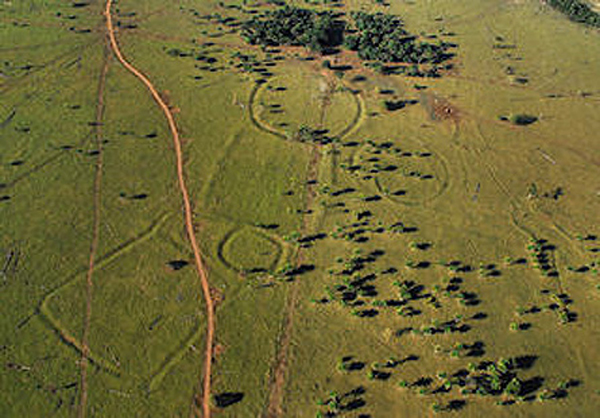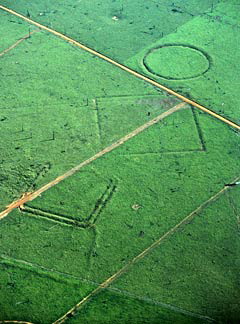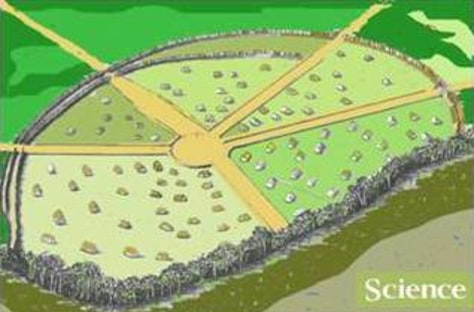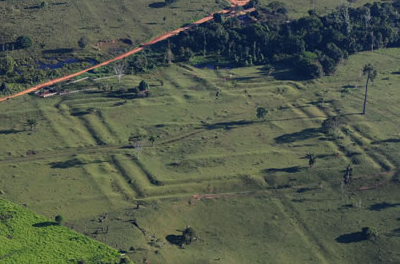Lasers Reveal a Maya Civilization So Dense It Blew Experts Minds
Source: New York Times
By JACEY FORTIN
FEB. 3, 2018

Tikal, home to temples and palaces, is one of the best known Maya sites in northern Guatemala.
Credit Justin Lane for The New York Times
They were hidden there, all this time, under the cover of tree canopies in the jungles of northern Guatemala: tens of thousands of structures built by the Maya over a millennium ago.
Not far from the sites tourists already know, like the towering temples of the ancient city of Tikal, laser technology has uncovered about 60,000 homes, palaces, tombs and even highways in the humid lowlands.
The findings suggested an ancient society of such density and interconnectedness that even the most experienced archaeologists were surprised.
“Everywhere that we looked, there was more settlement than we expected,” said Thomas Garrison, a National Geographic explorer and an archaeologist at Ithaca College. “We knew there was going to be more, but the scale of it really blew our minds.”
Read more: https://www.nytimes.com/2018/02/03/world/americas/mayan-city-discovery-laser.html
Judi Lynn
(160,525 posts)Deutsche Welle Published 12:42 p.m. ET Feb. 3, 2018
Researchers from Guatemala's PACUNAM foundation said on Thursday they had mapped the outlines of dozens of newly discovered Maya cities previously hidden deep in the jungle.
About 60,000 structures have been discovered over the past two years in the northern department of El Peten, which borders Mexico and Belize, according to Marcello Canuto, one of the project's senior investigators.
The findings are a "revolution in Maya archeology," Canuto said, adding that researchers now believe the Maya had a population of 10 million, "much higher" than previous estimates.
The discoveries include urban centers with sidewalks, homes, terraces, ceremonial centers, irrigation canals and fortifications, said Canuto, an archaeologist at Tulane University in the U.S.
More:
https://www.usatoday.com/story/news/world/2018/02/03/lasers-reveal-mayan-civilization-unimaginable-scale/303723002/
This story was originally published on DW.com. Its content is created separately from USA TODAY.
old guy
(3,283 posts)ornotna
(10,800 posts)LASER SCANS REVEAL MAYA “MEGALOPOLIS” BELOW GUATEMALAN JUNGLE
http://www.nationalgeographic.com.au/history/laser-scans-reveal-maya-megalopolis-below-guatemalan-jungle.aspx
Video
http://www.nationalgeographic.com.au/videos/the-lost-treasures-of-the-maya-snake-kings/the-lost-maya-city-5435.aspx
pwb
(11,261 posts)Form our 242 year old country. ![]()
What a wonderful ancient marvel.
orangecrush
(19,546 posts)Really enjoy your posts!
Orrex
(63,204 posts)quakerboy
(13,920 posts)Or Salt Lake City, maybe.
Wonder what the nightlife/music scene was like?
mr_lebowski
(33,643 posts)How the hell did this elude discovery simply by some person(s) hiking through the forest, or foraging, or hunting, or scavenging, etc ... then coming back and telling people that there's ruins of an amazing, giant Mayan city just sitting out there in the forest?
Seems like most of the countries populace would be well aware that being the 'discoverer' of such a find would have the potential to become famous as it's discoverer ... and similarly most would be aware that such a find would be a huge boon to tourism to their country, and would quickly be bringing in much-needed revenue.
Amazing to me that it's taken until now for anybody to 'discover' this and that it required fancy tech to make that happen. Unless it just so remote and difficult to access that the ONLY people that ever travel to this area are locals that have decided collectively for whatever reason, like they don't want to be overrun by tourists so they've all agree ... "we can't tell anyone about this!". Or maybe they have such minimal contact with the more urban denizens of their country that the information had no conduit to be passed along.
But there's just so many people in general these days, adventuring to remote wild places it just blow me away something this big and significant could still be 'hidden' in the world, simply by tree canopy and general remoteness. I mean, maybe on a deserted island somewhere, but Brazil/Belize border?
trippy...
FakeNoose
(32,634 posts)... and they're finding this crazy stuff.
But it's really sad that they're killing rain forests because it's all necessary for Earth's survival. Rain forests produce oxygen from CO2 and provide shelter for thousands of species of plants and animals.
![]()
joshcryer
(62,270 posts)In person they'd look like a hill or a mound or a pile of dead trees with plants growing on them. The LIDAR found them because it can see through the overgrowth.
Here's what one mound looks like:

I suspect the whole reason the project was started was because we already knew there were more unknown sites out there, people stumbled upon them in the past, all it takes is one archeologist to realize what is is. What's an easy way to just find lots of rock structures in a sprawling canopy that requires hours of bush wacking to get through? LIDAR. Now that they know where they are they can go to each of the sites and make paths for other people. Before you had to go "hey, I know of a mound at X location" and maybe show an unimpressive picture. Now they can take the LIDAR data and pitch to get the whole area revitalized.
Kashkakat v.2.0
(1,752 posts)foundations, road beds, etc. all became plainly visible - exciting stuff!!
a la izquierda
(11,791 posts)And this area is not the easiest place to get to, nor is it the safest.
Explorers have commented for centuries on anomalies that they thought were natural features. All over Mexico and Guatemala, places like this exist in plain site. You just have to know what you’re looking at.
Example: climb to the top of the Pyramid of the Sun in Teotihuacán, and have a look around. Everywhere you see are mounds covered by grass, waiting for excavation.
Kristofer Bry
(175 posts)
Judi Lynn
(160,525 posts)Baclava
(12,047 posts)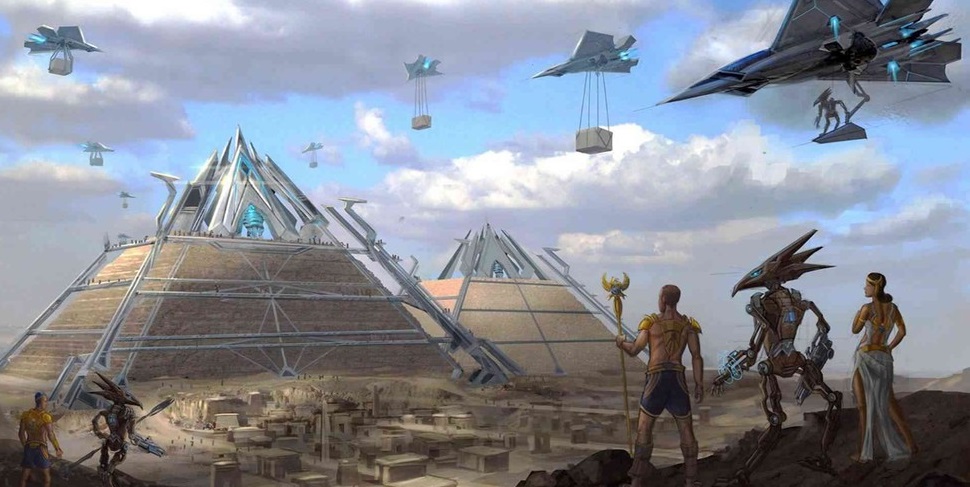
Where did you find this?
kwassa
(23,340 posts)Baclava
(12,047 posts)MountCleaners
(1,148 posts)I just got done reading books about Mayan civilization. I hope to travel there some day. I like to look for Mayan sites on Google Earth.
Kashkakat v.2.0
(1,752 posts)the very very 1st europeans reported cities, but disease (for which native am's had no immunity) swept through the native population ahead of the next europeans who came..... who then discounted the earlier reports as myth because they saw no cities (swallowed up by jungle within decades) and most of the native people they encountered were fugitive wandering bands without much property/material comfort. Its estimated that 90% or more of the native population was literally wiped out by disease - and thats not counting the later intentional genocidal acts.
Combine that tragedy with colonial/racist mindset ("these people are primitive/subhuman and so they deserve to have their land conquered" ) and there you have it -total ignorance about who was there first.
1491: the Americas Before Columbus is a really fun read - though prob somewhat dated by now what w/ new revelations in last few yrs. The author makes the brilliant observation that to consider Indians "savages" based on how they seemed after disease/violent attack by invaders would be like seeing european refugees during/afer world war 2 and assuming they never had culture or a civilization, and that they were incapable of ever having one.
Judi Lynn
(160,525 posts)in South America. It was so good to learn breakthroughs have started there, as well.
What a shame the very same vital, life-giving land which is under attack by greedy exploitive land grabbers who intend to take the trees, then use the land for cattle raising, etc. holds all the physical remnants of large, well-developed ancient civilizations.
Short views of discoveries:
Ancient Civilization in Brazil?
22 Jan 2010
By analysing satellite imagery and aerial photographs, archaeologists have detected patterns of avenues, ditches and enclosures that have lain concealed for centuries under a dense tangle of trees. These structures, up to 200 in number and collectively known as geoglyphs, give the lie to the theory that there were no complex societies in the Amazon Basin until the arrival of the Spanish and Portuguese in the 15th century. They haven't been precisely dated, but could be up to 2,000 years old. Spanning a distance of 155 miles, the earthworks are the remains of roads, bridges and squares that formed the basis for a lost civilization - the vestiges of a sophisticated pre-Columbian monument-building society.
The geoglyphs represent enourmous structures, with diameters ranging from 100 to 300 meters, connected by straight orthogonal roads. They are strategically located on plateaux tops above the river valleys. Their builders took advantage of the natural topography in order to construct spaces that were full of symbolic meaning. They were probably villages and ceremonial centres, indicating a society of a complex nature that allowed organization, planning, and large labor force. This suggests a substantial population was living in an area long believed to be too harsh to sustain permanent settlements.
However, this should not come as a great surprise; thermoluminescence and EPR dating of a calcite veneer which covers a rock painting at the Toca da Bastiana shelter in the Serra da Capivara National Park in the Piaui region of Brazil provides dates from 35 to 43 ka ago, implying that the painting is at least 36,000 years old.
The existence of rock art, and therefore a complex and sophisticated society, at such an early date fits perfectly with totally different and independent data obtained from the famous Pedra Furada
rock shelter in the same region.
Bradshaw Foundation
http://www.bradshawfoundation.com/news/archaeology.php?id=Ancient-Civilization-in-Brazil-
~ ~ ~ ~ ~
Evidence of Ancient Amazon Civilization Uncovered
by David Knowles
January 8, 2010
As Brazilian rain forest has been cleared away to make way for animal grazing,
the architectural footprint of a network of ancient villages has been revealed.
"The combination of land cleared of its rain forest for grazing and satellite survey have revealed a sophisticated pre-Columbian monument-building society in the upper Amazon basin on the east side of the Andes. This hitherto unknown people constructed earthworks of precise geometric plan connected by straight orthogonal roads," the researchers wrote in the journal.
David Grann, author of the book "The Lost City of Z," points out that the existence of the ruins overturns the previously held belief that this portion of the Amazon basin had always been a pristine wilderness, even though legends of a lost Amazonian city still lingered by the time the Spanish arrived on the continent.
"Although the early conquistadores had heard from the Indians about a fabulously rich Amazonian civilization, which they named El Dorado, the searches for it invariably ended in disaster," Grann wrote on The New Yorker's Web site. (below report)
"Thousands were wiped out by disease and starvation. And after a toll of death and suffering worthy of Joseph Conrad, most scholars concluded that El Dorado was no more than an illusion."
More:
http://www.bibliotecapleyades.net/arqueologia/amazoncivuncovered.htm
~ ~ ~
FINNISH ARCHAEOLOGIST DIGS UP ANCIENT CIVILIZATION IN BRAZIL
24 SEP , 2013
“Archaeologist Martti Pärssinen has made sensational finds of an ancient civilisation in the Amazonian area. The summer’s digs in Brazil have unearthed unique artefacts, including entirely new forms of ceramics.
The clearing of the Amazon rainforest has revealed mysterious patterns in the earth. The large-scale patterns are best visible from the air, where Finnish archaeologist Martti Pärssinen takes pictures of them.
The geometrical patterns have been made with earth mounds and moats. Many of them are huge, with sides measuring up to a few hundred metres. Over 300 such structures have been discovered in the Brazilian state of Acre alone.
The construction feat involved can be compared to that achieved by those that built the pyramids in Egypt.
More:
http://www.genesisquest.org/finnish-archaeologist-digs-ancient-civilization-brazil/
~ ~ ~
Search NBCNews.com
Nature's cover-up: An ancient Amazonian civilization
Evidence for a past civilization is subtle — so subtle that it can easily be mistaken for nature
Below:
Explainer
Image: Xinguano village
Michael Heckenberger and Jim Railey via Science/AAAS
An artist's conception shows a Xinguano village of the
Brazilian Amazon as it might have appeared before
1492. Archaeologists have found traces of wide,
curbed roads and managed parkland.
By Zahra Hirji
updated 9/9/2010 12:44:14 PM ET Print Font:
Spanish adventurer Gaspar de Carvajal wrote of "cities that gleamed white" and "very fruitful land," on his wanderings along the Eucadorian Napo River in 1541. But today there is little evidence of such a civilization. Instead this corner of the Amazon, like the rest of the massive tropical forest, is seemingly inhospitable: full of dense, obstructive vegetation and buzzing with poisonous creepy crawlers.
Is this a case of a Spaniard painting pretty pictures to pocket more money for future conquests, or an example of a perfectly executed cover-up directed by Mother Nature herself?
The Washington Post recently reported on the work of Augusto Oyuela-Caycedo of the University of Florida, who is part of a growing number of anthropologists who believe an ancient, advanced society once occupied Amazonia.
Though Oyuela-Caycedo and others do not necessarily take Carvajal at his word, they do believe that subtle soil disturbances in the Amazon landscape prove the past existence of a complex society — potentially even the one Carvajal claims he encountered.
More:
http://www.nbcnews.com/id/39079905/ns/technology_and_science-science#.WndhDainHIU
ETC.
